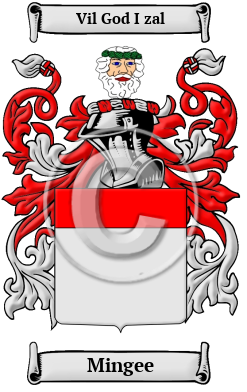| ![Show Contents]() Mingee History, Family Crest & Coats of Arms Mingee History, Family Crest & Coats of Arms
Etymology of MingeeWhat does the name Mingee mean? The earliest known forbear of the surname is Robert de Manieres, a Norman from Mesnieres, near Rouen, Normandy. His name appeared in the "Roll of Battle Abbey," an honor roll of all those who fought at the Battle of Hastings in 1066 AD. He was first granted land in Kent and Surrey under Odo, Bishop of Bayeux. One branch of the family remained in England to eventually become the Dukes of Rutland with the surname of Manners, the Normanized Saxon way of pronouncing this name. However, with growing dissatisfaction under the Conqueror's rule, one branch of the family (it is not certain whether this was the most senior branch) moved north, probably with Margaret, King Malcolm Ceanmore's second wife, where they were granted lands in Lothian. They moved from the Lowlands into the Highlands in about 1090. They settled in the Lands of Culdares in Glenylon. Mingee Coat of Arms CreationThis is a well-known Perthshire clan, and there are several important branches of it which have their own crests and mottoes. One of the chief is a Saracen's head. The motto is " Vil God I zall " (will God I shall). In Gaelic it is " Toileadh Dia e 's ni mise e." 1 Early Origins of the Mingee familyThe surname Mingee was first found in Midlothian, where it is quite understandable that the native Gaelic had difficulty with this Norman surname, and it can be found in various forms, among them: Mengues, Mingies and Meyners. The reason for these variations is the attempt to pronounce the "y" in Menyers (another variation of the original) in the Gaelic results in a cross between the sound of a "y" and that of a "g". Within a century the Clan was truly Gaelicized, although for Court purposes the first Chief retained the name of Sir Robert de Meyners. Sir Robert had risen in court circles, under King Alexander II to the position of Chamberlain of Scotland in 1249. The earliest surviving charter of this Clan is held by the Moncreiffes. In the Charter we find a grant of Lands of Culdares (now spelt Culdair) "as freely, quietly, fully and honorably as any Baron within the Kingdom of Scotland is able to give such land." The witnesses to this deed, which established a barony within the Earldom of Atholl, were David de Meyneris and also Alexander de Meyneris. Sir Robert was also granted lands in Rannoch that had belonged to King Alexander's own family. One cannot then help but conjecture that he had, in fact, married one of the King's daughters (that his sons took the Royal name of David, and Alexander may be evidence to this), however, this is not recorded. Sir Alexander, Sir Robert's son, was granted Aberfeldybeg in Strath Tay and the property of Weem. The reason for these grants is again not recorded, but we may draw the same conclusion. Early History of the Mingee familyThis web page shows only a small excerpt of our Mingee research. Another 250 words (18 lines of text) covering the years 1329, 1423, 1487, 1510, 1571, 1587, 1599, 1671 and 1890 are included under the topic Early Mingee History in all our PDF Extended History products and printed products wherever possible. Mingee Spelling VariationsSpelling variations of this family name include: Menzies, Menigees, Mennes, Mengzes, Menzeys, Minges, Méinn (Gaelic) and many more. Early Notables of the Mingee familyMore information is included under the topic Early Mingee Notables in all our PDF Extended History products and printed products wherever possible. Migration of the Mingee family to IrelandSome of the Mingee family moved to Ireland, but this topic is not covered in this excerpt.
Another 60 words (4 lines of text) about their life in Ireland is included in all our PDF Extended History products and printed products wherever possible. Migration of the Mingee familySome of the first settlers of this family name or some of its variants were: Archibald and Robert Menzies settled in Virginia in 1716; Mary Menzies settled in North Carolina in 1775; James Menzie settled in Philadelphia in 1868..
| Mingee Motto and War Cry | + |
The motto was originally a war cry or slogan. Mottoes first began to be shown with arms in the 14th and 15th centuries, but were not in general use until the 17th century. Thus the oldest coats of arms generally do not include a motto. Mottoes seldom form part of the grant of arms: Under most heraldic authorities, a motto is an optional component of the coat of arms, and can be added to or changed at will; many families have chosen not to display a motto.
Motto: Vil God I zal
Motto Translation: Will God I shall.
War Cry: " Gael 's dearg gu brath " (The red and white for
War Cry Description: This refers to the red and white standard of the Menzies.
- Polson, Alexander, The Romance of Scottish Crests and Mottoes. Inverness: Walter Alexander, Inglis Street 1929. Print
 |

